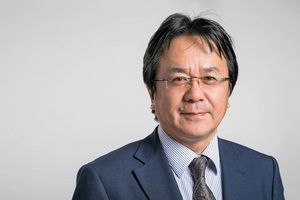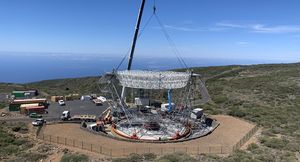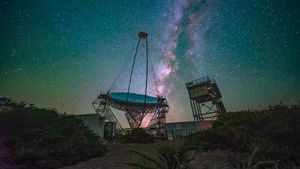Gamma rays give astrophysicists a completely different perspective on celestial objects than, say, optical light, infrared radiation or radio waves. They provide information on high-energy processes in the universe, such as black holes and supernova remnants.
A new observatory is being built to expand the options for observing gamma rays: The planned Cherenkov Telescope Array (CTA) consists of 120 individual telescopes that detect different gamma ray ranges, covering a wide energy spectrum. This will make it possible to capture even more details from fascinating celestial objects.
The observatory is being constructed at two locations, in the northern and southern hemispheres, so that the whole night sky is covered. There will be about 20 telescopes arranged near MAGIC on La Palma, and another 100 telescopes at the Paranal Observatory in Chile, operated by ESO.
The project is the responsibility of an international collaboration consisting of some 800 scientists and engineers around the world. The largest telescope type in the array is the LST (Large-Sized Telescope) with a mirror diameter of 23 meters. The MPP has a leading role in the LST development.
The LST records low-energy gamma rays in the range of 20 to 200 gigaelectronvolts. This will be used to study black holes at the center of far distant galaxies, as well as binary star systems and pulsars.
The smaller telescopes of 12 and 8 meters in diameter will capture higher-energy gamma rays.
First prototype on La Palma
The Max Planck Institute for Physics has been involved in the construction of the first LST prototype. The LST-1 was built right beside the two MAGIC telescopes and inaugurated in 2018. Six research institutions from five countries had joined to co-operate in the LST-1 project.
The MPP was responsible for the substructure, the mechanical configuration, the rail system and parts of the camera mounting.
CTA at the MPP
Group members
[Translate to English:] CTA Gruppenmitglieder
E-mail address: e-mail@mpp.mpg.de
Phone number: +49 89 32354-extension
name
function
e-mail
extension
office
Altwasser, Doris
Secretary
doris.altwasser
364
A.2.43
Arbet-Engels, Axel, Dr.
Postdoc
axel.arbet-engels
289
A.2.38
Berti, Alessio
Postdoc
alessio.berti
227
A.2.50
Ceribella, Giovanni, Dr.
Postdoc
giovanni.ceribella
291
A.1.61
Chon, Gayoung, PD Dr.
Senior Scientist
gayoung.chon
328
A.1.23
Cicciari, Gloria Maria
gloria.cicciari
227
A.2.50
Gaborit-Reitz, Lucas
Student
lucas.gaborit-reitz
312
A.1.23
Green, Jarred Gershon
PhD Student
jarred.green
259
A.2.44
Hahn, Alexander
PhD Student
alexander.hahn
421
A.2.46
Jimenez Martinez, Irene, Dr.
Postdoc
irene.jimenez
364
A.2.52
Mirzoyan, Razmik, Dr.
Senior Scientist
razmik.mirzoyan
328
A.2.34
Nozaki, Seiya, Dr.
Postdoc
seiya.nozaki
227
A.2.50
Paneque, David, Dr.
Senior Scientist
david.paneque
349
A.2.36
Peresano, Michele, Dr.
Postdoc
michele.peresano
543
A.2.52
Pirola, Giorgio
PhD Student
giorgio.pirola
259
A.2.44
Schweizer, Thomas, Dr.
Senior Scientist
thomas.schweizer
227
A.2.32
Scola, Lalo
Student
lalo.scola
364
A.2.54
Teshima, Masahiro, Dr.
Director
masahiro.teshima
301
A.2.41
Wang, Yunhe
Student
yunhe.wang
312
A.2.52
Werner, Diana
Secretary
diana.werner
364
A.2.43
Ünver, Asu Nisa
Student
asu.unver
291
A.1.61
Group members
[Translate to English:] CTA Gruppenmitglieder
Phone number: +49 89 32354-extension
| name | function | extension | office | |
|---|---|---|---|---|
| Altwasser, Doris | Secretary | doris.altwasser | 364 | A.2.43 |
| Arbet-Engels, Axel, Dr. | Postdoc | axel.arbet-engels | 289 | A.2.38 |
| Berti, Alessio | Postdoc | alessio.berti | 227 | A.2.50 |
| Ceribella, Giovanni, Dr. | Postdoc | giovanni.ceribella | 291 | A.1.61 |
| Chon, Gayoung, PD Dr. | Senior Scientist | gayoung.chon | 328 | A.1.23 |
| Cicciari, Gloria Maria | gloria.cicciari | 227 | A.2.50 | |
| Gaborit-Reitz, Lucas | Student | lucas.gaborit-reitz | 312 | A.1.23 |
| Green, Jarred Gershon | PhD Student | jarred.green | 259 | A.2.44 |
| Hahn, Alexander | PhD Student | alexander.hahn | 421 | A.2.46 |
| Jimenez Martinez, Irene, Dr. | Postdoc | irene.jimenez | 364 | A.2.52 |
| Mirzoyan, Razmik, Dr. | Senior Scientist | razmik.mirzoyan | 328 | A.2.34 |
| Nozaki, Seiya, Dr. | Postdoc | seiya.nozaki | 227 | A.2.50 |
| Paneque, David, Dr. | Senior Scientist | david.paneque | 349 | A.2.36 |
| Peresano, Michele, Dr. | Postdoc | michele.peresano | 543 | A.2.52 |
| Pirola, Giorgio | PhD Student | giorgio.pirola | 259 | A.2.44 |
| Schweizer, Thomas, Dr. | Senior Scientist | thomas.schweizer | 227 | A.2.32 |
| Scola, Lalo | Student | lalo.scola | 364 | A.2.54 |
| Teshima, Masahiro, Dr. | Director | masahiro.teshima | 301 | A.2.41 |
| Wang, Yunhe | Student | yunhe.wang | 312 | A.2.52 |
| Werner, Diana | Secretary | diana.werner | 364 | A.2.43 |
| Ünver, Asu Nisa | Student | asu.unver | 291 | A.1.61 |
Key publications
Search response:
22 publications match your query. Listing starts with latest publication first: (1 - 3)
MPP-2025-93 Detection of RS Oph with LST-1 and modelling of its HE/VHE gamma-ray emission, CTA-LST Project, K. Abe, S. Abe, A. Abhishek, et al., Astron.Astrophys. 695 (2025) A152, arxiv:2503.13283 (abs), (pdf), (ps), (External full text link), inSPIRE entry.
[CTA], [Article]
MPP-2025-28 Unveiling the largest structures in the nearby Universe: Discovery of the Quipu superstructure, Hans Boehringer, Gayoung Chon, Joachim Truemper, Renee C. Kraan-Korteweg, Norbert Schartel, (Full text), Astron.Astrophys. 695 (2025) A59, arxiv:2501.19236 (abs), (pdf), (ps), (External full text link), inSPIRE entry.
[CTA], [Article]
MPP-2024-371 Dark Matter Line Searches with the Cherenkov Telescope Array, S. Abe, J. Abhir, A. Abhishek, F. Acero, et al., JCAP 07 (2024) 047, arxiv:2403.04857 (abs), (pdf), (ps), inSPIRE entry.
[CTA], [Article]
Key publications
Search response: 22 publications match your query. Listing starts with latest publication first: (1 - 3)
MPP-2025-93 Detection of RS Oph with LST-1 and modelling of its HE/VHE gamma-ray emission, CTA-LST Project, K. Abe, S. Abe, A. Abhishek, et al., Astron.Astrophys. 695 (2025) A152, arxiv:2503.13283 (abs), (pdf), (ps), (External full text link), inSPIRE entry.
[CTA], [Article]
MPP-2025-28 Unveiling the largest structures in the nearby Universe: Discovery of the Quipu superstructure, Hans Boehringer, Gayoung Chon, Joachim Truemper, Renee C. Kraan-Korteweg, Norbert Schartel, (Full text), Astron.Astrophys. 695 (2025) A59, arxiv:2501.19236 (abs), (pdf), (ps), (External full text link), inSPIRE entry.
[CTA], [Article]
MPP-2024-371 Dark Matter Line Searches with the Cherenkov Telescope Array, S. Abe, J. Abhir, A. Abhishek, F. Acero, et al., JCAP 07 (2024) 047, arxiv:2403.04857 (abs), (pdf), (ps), inSPIRE entry.
[CTA], [Article]










